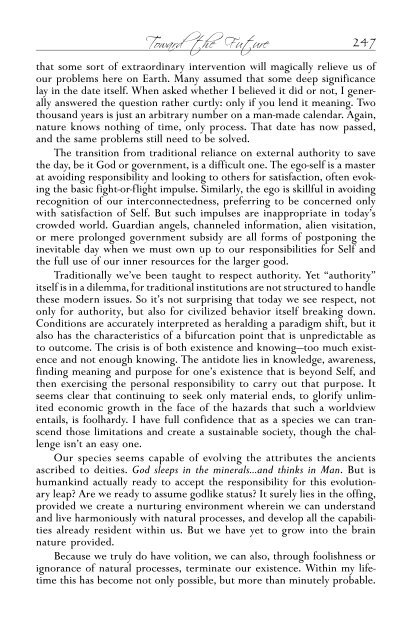edgar-mitchell
edgar-mitchell
edgar-mitchell
Create successful ePaper yourself
Turn your PDF publications into a flip-book with our unique Google optimized e-Paper software.
124<br />
The Way of the Explorer<br />
them, as they are each incomplete models. From the time of Descartes’<br />
dualism, through the later philosophy of materialism, consciousness wasn’t<br />
a subject of interest in mainstream science; real interest wasn’t generated<br />
until the final decade of the 20th century. However, when the theory of<br />
quantum mechanics was solidly framed in 1927, it was becoming obvious<br />
that consciousness could no longer be ignored, as it seemed to possess<br />
some of the fundamental pieces to the puzzle that physicists and cosmologists<br />
themselves were trying to fit together. The struggle of individual scientists<br />
adapting their views from that of Newtonian reality to that of<br />
quantum reality was not unlike the difficulty each of us encounters in<br />
adapting our worldview to the rapid changes of the last 100 years or so.<br />
The drama always begins when we realize that something about our world<br />
is different than we previously thought, and cannot be explained with<br />
existing knowledge.<br />
Scientists of the 19th century believed (but were absolutely convinced<br />
they knew) that the tangible substances of nature, such as rocks and trees,<br />
possessed fundamental physical characteristics measurable and completely<br />
described in terms of length, mass, chemical content, and the like. Measures<br />
related to the appearance of things. Energy was not a fundamental<br />
property, but one mathematically derived by describing natural bodies in<br />
motion. The story of quantum mechanics (and to a lesser extent, relativity)<br />
is the story of discovering that matter in motion does not only possess<br />
energy, but rather that matter is energy-solidified energy. In a sense, matter<br />
is the death of free energy, being one of the ways it transforms into<br />
physical reality (just as matter can be transformed back into energy). When<br />
this idea was brought into the picture, our earlier understanding and thought<br />
structures about matter were turned upside down. Atomic matter is not<br />
like tiny ping-pong balls, but is rather a continuous flux of energy combining<br />
and splitting. It only appears on our scale as solid matter.<br />
Recognizing that energy is more fundamental than its appearance as<br />
just an attribute of matter has been an agonizing process that is only now<br />
finding its way into public awareness. The appearance of things always<br />
seems more “real” than the invisible world from which they emerge. Before<br />
we are finished with discovery altogether, we will find that “knowing”<br />
is also not secondary, but results from a fundamental property of<br />
nature. First, however, it is important to understand what “knowing” is.<br />
Since the time of Newton, scientists and mathematicians have not<br />
looked seriously at “mind,” relegating it to the realm of theology. They came<br />
to believe nature was embedded with mathematics and the laws of physics—<br />
absolute rules of order waiting to be discovered. Mind came to be considered<br />
a secondary phenomenon that evolved and eventually allowed humans<br />
to discover the absolutes. In due course, the complexities of the brain could<br />
be understood, and that would solve the riddle of mind. The mystic, on the


